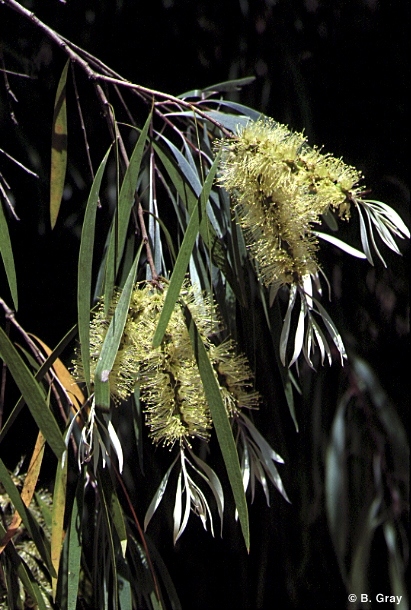Australian Tropical Rainforest Plants - Online edition
Melaleuca argentea W.Fitzg.




Fitzgerald, W.V. (1918) Journal and Proceedings of the Royal Society of Western Australia 3: 187. Type: Isdell, Charnley, Fitzroy, Ord, Denham Rivers, etc. (W.V.F.).
Paperbark, Silver; Paperbark, Silver-leaved; Silver Leaf Cadjeput; Silver Paperbark; Silver-leaved Paperbark; Silvery Weeping Tea Tree
Usually grows into a medium-sized tree and is usually found along creeks and watercourses. Bark papery.
Leaf blades pendulous, about 7-12 x 0.6-1.5 cm, margins thickened somewhat vein-like, petioles about 0.3-1 cm long. Oil dots quite numerous, not enclosed in reticulations. Venation longitudinal and parallel with about 3-5 veins more prominent than the rest. Younger leaf blades densely clothed in fine prostrate silvery hairs. Leaves aromatic when crushed.
Spikes about 7-8 mm long. Individual flowers about 10-15 mm diam. Calyx lobes about 0.7-1.1 mm long, apex obtuse. Petals about 2.3-3.7 x 1.6-3 mm with about 6 or 7 slightly elongated oil dots. Stamens about 25-35, united in five bundles. Filaments about 8-20 mm long. Anthers about 0.6-0.9 mm long with a gland on the back. Style about 12-22 mm long. Base of the style surrounded by a nectar-producing disk.
Fruits shortly cylindrical, about 3-4 x 3-4 mm, valves enclosed. Seeds about 1 mm long, numerous, mixed with chaff. Embryo about 1 mm long, cotyledons about 0.5 mm long, folded down over the radicle. Radicle about 0.5 mm long.
Cotyledons orbicular to obovate, about 2.2 x 1 mm, petioles about 1.2 mm long. First pair of leaves about 4.5-5 x 2 mm. Oil dots small, closely spaced. At the tenth leaf stage: leaf blade about 40 x 3 mm, lateral veins about 5 or 6 on each side of the midrib. Petiole about 2.5 mm long. Seed germination time 6 to 9 days.
Although this tree can grow large, it will flower as a shrub. It is a very useful ornamental for moist areas in larger gardens. Its foliage is silvery, the cream, perfumed 'bottle brush' flowers attract numerous bird species.
This species may have been used as fish poison. (http://share.geocities.com/Athens/Delphi/2970/poi son.htm)





